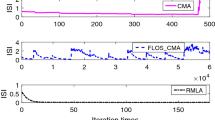Abstract
To solve the significant performance degradation in the blind equalization for multi-level quadrature amplitude modulation (QAM) signals, an improved multimodulus algorithm based on the real part (or the imaginary part) of the transmitted signals is developed in this paper. Theoretical analysis illustrates that the proposed algorithm can roughly half the computational complexity and fundamentally suppress the well-known steady-state maladjustment of classical constant modulus algorithm and multimodulus algorithm. Moreover, the large maladjustment in the iteration process can be completely removed, thus the proposed algorithm can work well in impulsive noise environment. Finally, simulation results show the effectiveness of the proposed algorithm under both Gaussian and impulsive noise environments.






Similar content being viewed by others
References
Liu, M., Liu, C., Chen, Y., Yan, Z., & Zhao, N. (2022). Radio frequency fingerprint collaborative intelligent blind identification for green radios. IEEE Transactions on Green Communications and Networking. https://doi.org/10.1109/TGCN.2022.3185045
Liu, M., Zhang, H., Liu, Z., & Zhao, N. (2022). Attacking spectrum sensing with adversarial deep learning in cognitive radio-enabled internet of things. IEEE Transactions on Reliability. https://doi.org/10.1109/TR.2022.3179491
Liu, M., Zhang, Z., Chen, Y., Ge, J., & Zhao, N. (2023). Adversarial attack and defense on deep learning for air transportation communication jamming. IEEE Transactions on Intelligent Transportation Systems. https://doi.org/10.1109/TITS.2023.3262347
Zhang, J., Liu, M., Zhao, N., Chen, Y., Yang, Q., & Ding, Z. (2022). Spectrum and energy efficient multi-antenna spectrum sensing for green UAV communication. Digital Communications and Networks. https://doi.org/10.1016/j.dcan.2022.09.017
Chen, S. (2003). Low complexity concurrent constant modulus algorithm and soft directed scheme for blind equalization. IEE Proceedings-Vision, Image, and Signal Processing., 150(5), 312–320.
Fernandes, M. (2015). Linear programming applied to blind signal equalization. AEU-International Journal of Electronics and Communications, 69, 408–417.
Yang, J., Werner, J., & Dumont, G. (2002). The multimodulus blind equalization and its generalized algorithms. IEEE Journal on Selected Areas in Communications, 20(5), 997–1015.
Pawar, V., Pawar, R., & Naik, K. (2018). Blind time-domain equalizer for doubly-selective channel with reduced time averaging and computational complexity. AEU-Int J Electron Commun, 94, 187–198.
Yuan, J., & Lin, T. (2010). Equalization and carrier phase recovery of CMA and MMA in blind adaptive receivers. IEEE Transactions on Signal Processing, 58(6), 3206–3217.
Abrar, S., & Nandi, A. (2010). Blind equalization of square-QAM signals: A multimodulus approach. IEEE Transactions on Communications, 58(6), 1674–1685.
Szczecinski, L., & Gei, A. (2002). Blind decision feedback equalisers, how to avoid degenerated solutions. Signal Processing, 82(11), 1675–1693.
Li, J., Feng, D., & Li, B. (2018). A robust adaptive weighted constant modulus algorithm for blind equalization of wireless communications systems under impulsive noise environment. AEU-Int J Electron Commun., 83, 150–155.
Xie, N., Hu, H., & Wang, H. (2012). A new hybrid blind equalization algorithm with steady-state performance analysis. Digital Signal Process., 22(2), 233–237.
Lin, D., Hu, S., Wu, W., & Wu, G. (2023). Few-shot RF fingerprinting recognition for secure satellite remote sensing and image processing. Science China Information Sciences. https://doi.org/10.1007/s11432-022-3672-7
Yang, Z., Li, D., Zhao, N., Wu, Z., Li, Y., & Niyato, D. (2022). Secure precoding optimization for NOMA-aided integrated sensing and communication. IEEE Transactions on Communications, 70(12), 8370–8382.
Lu, W., Mo, Y., Feng, Y., Gao, Y., Zhao, N., Wu, Y., & Nallanathan, A. (2022). Secure transmission for multi -UAV-assisted mobile edge computing based on reinforcement learning. IEEE Transactions on Network Science and Engineering. https://doi.org/10.1109/TNSE.2022.3185130
Tsakalides, P., & Nikias, C. (1995). Maximum likelihood localization of sources in noise modeled as a stable process. IEEE Transactions on Signal Processing, 43(11), 2700–2713.
Stojanovic, M., & Preisig, J. (2009). Underwater acoustic communication channels: Propagation modelsand statistical characterization. IEEE Communications Magazine, 47(1), 84–89.
Shah, S., Samar, R., & Naqvi, S. (2014). Fractional order constant modulus blind algorithms with application to channel equalization. Electronics Letters., 50(23), 1702–1704.
Li, J., Lu, J., & Zhao, J. (2010). A robust constant modulus algorithm in alpha-stable noise environments. In IEEE 10th International conference on signal processing proceedings (pp. 1589-1592). IEEE.
Funding
This work was supported by the National Natural Science Foundation of China under Grant 61971429.
Author information
Authors and Affiliations
Contributions
XZ: methodology, writing-original draft, software, validation. YL: conceptualization, writing-review & editing.
Corresponding author
Ethics declarations
Conflict of interest
The authors declare that they have no known competing financial interests of personal relationships that could have appeared to influence the work reported in this paper.
Additional information
Publisher's Note
Springer Nature remains neutral with regard to jurisdictional claims in published maps and institutional affiliations.
Rights and permissions
Springer Nature or its licensor (e.g. a society or other partner) holds exclusive rights to this article under a publishing agreement with the author(s) or other rightsholder(s); author self-archiving of the accepted manuscript version of this article is solely governed by the terms of such publishing agreement and applicable law.
About this article
Cite this article
Zhang, X., Li, Y. Improved mutimodulus blind equalization algorithm for multi-level QAM signals with impulsive noise. Wireless Netw (2023). https://doi.org/10.1007/s11276-023-03398-2
Accepted:
Published:
DOI: https://doi.org/10.1007/s11276-023-03398-2




